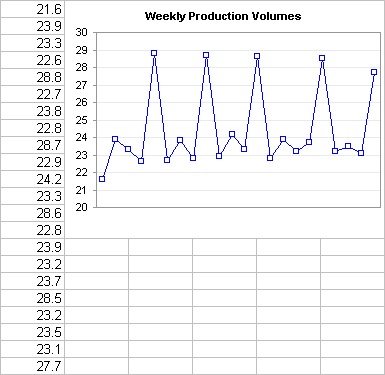A simple chart can be very useful to check for patterns or errors in your data. Such features of the data may be difficult or impossible to find in the tabulated data, but they jump out from a simple chart.
Jorge Camoes suggests in Validate Your Tables – US Census Bureau Example that we make a quick chart to make sure the data “looks” correct. Jorge was looking at some data from the US Census Bureau, and it didn’t seem correct. So he made a simple plot.

As Jorge says, “Can you see [the error] now? Of course you can. Try not to see it…”
Jorge’s simple example is a great illustration. The following is another great example of how much easier it is to see patterns in charts than in tabulated data. This example is taken from Understanding Variation: The Key to Managing Chaos, by Donald J. Wheeler.
 |
This small, 136-page book is very useful because of its down-to-earth approach to SPC and its reliance on real business and manufacturing examples. I’ve cited other examples from this book in my post Introducing Control Charts (Run Charts). |
Here is the weekly production data for a plant, as presented in Understanding Variation, and unfortunately as it would be presented in so many formal and informal reports in business and industry.

Do you see any patterns? Sure. Right. The first step towards clarity is to put the data into a single list (CSV file), and make a simple line chart. This type of chart, which shows sequential values along a line chart, is called a control chart or run chart and it is a basic component of Statistical Process Control.

As Jorge might say, “Can you see [the pattern] now? Of course you can. Try not to see it…”. When you look at the complete picture, and include dates (CSV file), you can even form a hypothesis about why the pattern exists.

I’ve made up the dates to go with the production figures, but only to help the illustration. Anyone who has worked in a production environment, in fact, any environment in which there are requirements due at regular intervals, knows this general pattern. Every week, some of the monthly quota is met, but in the last week of the month, there is a flurry of activity needed to actually meet the monthly quota. This is simple human nature of course, the same characteristic that leads to an all-nighter whenever a term paper is due.
Further Reading about Statistical Process Control
- ISO 9001 – Introduction to SPC
- Control Charts on Wikipedia
- Interpreting Control Charts
- Selecting the Right Control Chart


